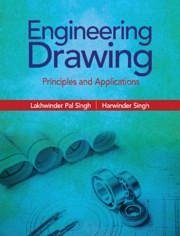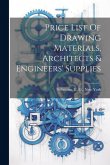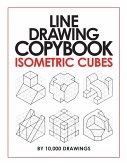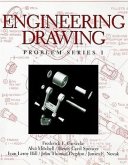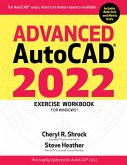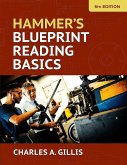- Broschiertes Buch
- Merkliste
- Auf die Merkliste
- Bewerten Bewerten
- Teilen
- Produkt teilen
- Produkterinnerung
- Produkterinnerung
This textbook introduces the basic concepts of engineering drawing and graphics, supplemented with numerous solved examples and exercises.
Andere Kunden interessierten sich auch für
![Price List Of Drawing Materials, Architects & Engineers' Supplies Price List Of Drawing Materials, Architects & Engineers' Supplies]() Price List Of Drawing Materials, Architects & Engineers' Supplies25,99 €
Price List Of Drawing Materials, Architects & Engineers' Supplies25,99 €![Line Drawing Copybook Isometric Cubes Line Drawing Copybook Isometric Cubes]() DrawingsLine Drawing Copybook Isometric Cubes25,99 €
DrawingsLine Drawing Copybook Isometric Cubes25,99 €![Computational Modeling for Fluid Flow and Interfacial Transport Computational Modeling for Fluid Flow and Interfacial Transport]() Wei ShyyComputational Modeling for Fluid Flow and Interfacial Transport26,99 €
Wei ShyyComputational Modeling for Fluid Flow and Interfacial Transport26,99 €![Engineering Drawing, Problem Series 1 Engineering Drawing, Problem Series 1]() Frederick GieseckeEngineering Drawing, Problem Series 148,99 €
Frederick GieseckeEngineering Drawing, Problem Series 148,99 €![Advanced Autocad(r) 2022 Exercise Workbook Advanced Autocad(r) 2022 Exercise Workbook]() Cheryl R ShrockAdvanced Autocad(r) 2022 Exercise Workbook80,99 €
Cheryl R ShrockAdvanced Autocad(r) 2022 Exercise Workbook80,99 €![Hammer's Blueprint Reading Basics Hammer's Blueprint Reading Basics]() Charles GillisHammer's Blueprint Reading Basics69,99 €
Charles GillisHammer's Blueprint Reading Basics69,99 €![Engineering Drawing - A Practical Approach Engineering Drawing - A Practical Approach]() Sheojee PrasadEngineering Drawing - A Practical Approach24,99 €
Sheojee PrasadEngineering Drawing - A Practical Approach24,99 €-
-
-
This textbook introduces the basic concepts of engineering drawing and graphics, supplemented with numerous solved examples and exercises.
Hinweis: Dieser Artikel kann nur an eine deutsche Lieferadresse ausgeliefert werden.
Hinweis: Dieser Artikel kann nur an eine deutsche Lieferadresse ausgeliefert werden.
Produktdetails
- Produktdetails
- Verlag: Cambridge University Press
- Seitenzahl: 632
- Erscheinungstermin: 5. August 2021
- Englisch
- Abmessung: 239mm x 196mm x 25mm
- Gewicht: 816g
- ISBN-13: 9781108707725
- ISBN-10: 1108707726
- Artikelnr.: 60479055
- Herstellerkennzeichnung
- Libri GmbH
- Europaallee 1
- 36244 Bad Hersfeld
- gpsr@libri.de
- Verlag: Cambridge University Press
- Seitenzahl: 632
- Erscheinungstermin: 5. August 2021
- Englisch
- Abmessung: 239mm x 196mm x 25mm
- Gewicht: 816g
- ISBN-13: 9781108707725
- ISBN-10: 1108707726
- Artikelnr.: 60479055
- Herstellerkennzeichnung
- Libri GmbH
- Europaallee 1
- 36244 Bad Hersfeld
- gpsr@libri.de
Dr Lakhwinder Pal Singh is an associate professor in the department of industrial and production engineering at Dr. B. R. Ambedkar National Institute of Technology, Jalandhar. He has taught courses on engineering drawing, supply chain management, work study and ergonomics. His area of interest includes human factors engineering, production and operations management, lean manufacturing, occupational health and safety, and supply chain management.
Preface
Chapter 1: Drawing Instruments
1.1 Introduction
1.2 List of Draughting Tools
1.3 Drawing Board
1.4 Mini-Draughter
1.5 Small Instrument Box
1.6 Set Squares
1.7 Set of Scales
1.8 Protractor
1.9 French Curves
1.10 Drawing Sheets
1.11 Drawing Pencils
1.12 Paper Fasteners
1.13 Sand Paper Pad
1.14
Eraser
1.15 Duster
Exercises
Objective Questions
Answers
Chapter 2: Lines, Lettering and Layout of Sheet
2.1 Introduction
2.2 Lines
2.3 Lettering
2.4 Single Stroke Letters
2.5 Gothic Letters
2.6 General Proportions of Letters
2.7 Drawing Sheet Layout
2.8 Title Block
Exercises
Objective Questions
Answers
Chapter 3: Principles of Dimensioning
3.1 Introduction
3.2 Types of Dimensions
3.3 Elements of Dimensioning
3.4 Execution of Dimensions
3.5 Placing of Dimensions
3.6 Methods of Dimensioning
3.7 Principles of Dimensioning
Exercises
Objective Questions
Answers
Chapter 4: Sections and Conventions
4.1 Introduction
4.2 Cutting Plane or Sectional Plane
4.3 Section Lines or Hatching Lines
4.4 Types of Section
4.5 Conventions for Various Materials
4.6 Conventional Breaks
4.7 Conventional Representation of Common Features
Exercises
Objective Questions
Answers
Chapter 5: Geometrical Constructions
5.1 Introduction
5.2 Bisection of a Straight Line
5.3 Dividing a Line Into Equal Parts
5.4 Draw a Line Parallel to a Given Straight Line
5.5 Bisect an Angle
5.6 Find the Centre of an Arc
5.7 Constructing an Equilateral Triangle
5.8 Construct Squares
5.9 Construct a Regular Polygons
5.10 To Draw Tangents
5.11 Inscribed Circles
Exercises
Objective Questions
Answers
Chapter 6: Scales
6.1 Introduction
6.2 Representative Fraction or Scale Factor
6.3 Scales on Drawings
6.4 Types of Scales
6.5 Plain Scales
6.6 Diagonal Scales
Exercises
Objective Questions
Answers
Chapter 7: Orthographic Projections
7.1 Introduction
7.2 Methods of Projections
7.2.1 Perspective Projection
7.2.2 Parallel Projection
7.3 Planes of Projection
7.4 Four Quadrants
7.5 First-Angle Projection
7.6 Third-Angle Projection
7.7 Symbols Used for First-Angle Projection and Third-Angle Projection Methods
Exercises
Objective Questions
Answers
Chapter 8 Projections of Points: 8.1 Introduction
8.2 Projection of a Point Lying in the First Quadrant
8.3 Projection of a Point Lying in the Second Quadrant
8.4 Projection of a Point Lying in the Third Quadrant
8.5 Projection of Point Lying in the Fourth Quadrant
8.6 Special Cases
8.7 A Point is Situated in the Three Planes of Projection
Exercises
Objective Questions
Answers
Chapter 9: Projections of Lines
9.1 Introduction
9.2 Position of a Straight Line
9.3 Line Parallel to Both HP and VP
9.4 Line Inclined to One Plane and Parallel to the Other
9.5 Line Perpendicular to One of the Planes
9.6 Line Contained by One or Both of the Principal Planes
9.7 Line Inclined to Both HP And VP
9.8 Line Contained by a Profile Plane (PP) or Line Contained by a Plane, Perpendicular to Both HP and VP
9.9 Traces of a Line
Exercises
Objective Questions
Answers
Chapter 10: Projections of Planes
10.1 Introduction
10.2 Types of Planes
10.3 Traces of Planes
10.4 A Secondary Plane in Different Positions with Respect to the Principal Planes
10.5 Projections of Plane Parallel to One of the Principal Planes
10.6 Projections of Plane Perpendicular to Both HP and VP
10.7 Projections of Plane Inclined to One of the Principal Planes and Perpendicular to the other Plane
10.8 Projections of Plane Inclined to Both the Principal Planes
Exercises
Objective Questions
Answers
Chapter 11: Auxiliary Projections
11.1 Introduction
11.2 Types of Auxiliary Planes and Views
11.3 Projections of Points
11.4 Projections of Straight Lines
11.5 Projections of Planes
11.6 Shortest Distance between two Skew Lines
Additional Problems
Exercises
Objective Questions
Chapter 1: Drawing Instruments
1.1 Introduction
1.2 List of Draughting Tools
1.3 Drawing Board
1.4 Mini-Draughter
1.5 Small Instrument Box
1.6 Set Squares
1.7 Set of Scales
1.8 Protractor
1.9 French Curves
1.10 Drawing Sheets
1.11 Drawing Pencils
1.12 Paper Fasteners
1.13 Sand Paper Pad
1.14
Eraser
1.15 Duster
Exercises
Objective Questions
Answers
Chapter 2: Lines, Lettering and Layout of Sheet
2.1 Introduction
2.2 Lines
2.3 Lettering
2.4 Single Stroke Letters
2.5 Gothic Letters
2.6 General Proportions of Letters
2.7 Drawing Sheet Layout
2.8 Title Block
Exercises
Objective Questions
Answers
Chapter 3: Principles of Dimensioning
3.1 Introduction
3.2 Types of Dimensions
3.3 Elements of Dimensioning
3.4 Execution of Dimensions
3.5 Placing of Dimensions
3.6 Methods of Dimensioning
3.7 Principles of Dimensioning
Exercises
Objective Questions
Answers
Chapter 4: Sections and Conventions
4.1 Introduction
4.2 Cutting Plane or Sectional Plane
4.3 Section Lines or Hatching Lines
4.4 Types of Section
4.5 Conventions for Various Materials
4.6 Conventional Breaks
4.7 Conventional Representation of Common Features
Exercises
Objective Questions
Answers
Chapter 5: Geometrical Constructions
5.1 Introduction
5.2 Bisection of a Straight Line
5.3 Dividing a Line Into Equal Parts
5.4 Draw a Line Parallel to a Given Straight Line
5.5 Bisect an Angle
5.6 Find the Centre of an Arc
5.7 Constructing an Equilateral Triangle
5.8 Construct Squares
5.9 Construct a Regular Polygons
5.10 To Draw Tangents
5.11 Inscribed Circles
Exercises
Objective Questions
Answers
Chapter 6: Scales
6.1 Introduction
6.2 Representative Fraction or Scale Factor
6.3 Scales on Drawings
6.4 Types of Scales
6.5 Plain Scales
6.6 Diagonal Scales
Exercises
Objective Questions
Answers
Chapter 7: Orthographic Projections
7.1 Introduction
7.2 Methods of Projections
7.2.1 Perspective Projection
7.2.2 Parallel Projection
7.3 Planes of Projection
7.4 Four Quadrants
7.5 First-Angle Projection
7.6 Third-Angle Projection
7.7 Symbols Used for First-Angle Projection and Third-Angle Projection Methods
Exercises
Objective Questions
Answers
Chapter 8 Projections of Points: 8.1 Introduction
8.2 Projection of a Point Lying in the First Quadrant
8.3 Projection of a Point Lying in the Second Quadrant
8.4 Projection of a Point Lying in the Third Quadrant
8.5 Projection of Point Lying in the Fourth Quadrant
8.6 Special Cases
8.7 A Point is Situated in the Three Planes of Projection
Exercises
Objective Questions
Answers
Chapter 9: Projections of Lines
9.1 Introduction
9.2 Position of a Straight Line
9.3 Line Parallel to Both HP and VP
9.4 Line Inclined to One Plane and Parallel to the Other
9.5 Line Perpendicular to One of the Planes
9.6 Line Contained by One or Both of the Principal Planes
9.7 Line Inclined to Both HP And VP
9.8 Line Contained by a Profile Plane (PP) or Line Contained by a Plane, Perpendicular to Both HP and VP
9.9 Traces of a Line
Exercises
Objective Questions
Answers
Chapter 10: Projections of Planes
10.1 Introduction
10.2 Types of Planes
10.3 Traces of Planes
10.4 A Secondary Plane in Different Positions with Respect to the Principal Planes
10.5 Projections of Plane Parallel to One of the Principal Planes
10.6 Projections of Plane Perpendicular to Both HP and VP
10.7 Projections of Plane Inclined to One of the Principal Planes and Perpendicular to the other Plane
10.8 Projections of Plane Inclined to Both the Principal Planes
Exercises
Objective Questions
Answers
Chapter 11: Auxiliary Projections
11.1 Introduction
11.2 Types of Auxiliary Planes and Views
11.3 Projections of Points
11.4 Projections of Straight Lines
11.5 Projections of Planes
11.6 Shortest Distance between two Skew Lines
Additional Problems
Exercises
Objective Questions
Preface
Chapter 1: Drawing Instruments
1.1 Introduction
1.2 List of Draughting Tools
1.3 Drawing Board
1.4 Mini-Draughter
1.5 Small Instrument Box
1.6 Set Squares
1.7 Set of Scales
1.8 Protractor
1.9 French Curves
1.10 Drawing Sheets
1.11 Drawing Pencils
1.12 Paper Fasteners
1.13 Sand Paper Pad
1.14
Eraser
1.15 Duster
Exercises
Objective Questions
Answers
Chapter 2: Lines, Lettering and Layout of Sheet
2.1 Introduction
2.2 Lines
2.3 Lettering
2.4 Single Stroke Letters
2.5 Gothic Letters
2.6 General Proportions of Letters
2.7 Drawing Sheet Layout
2.8 Title Block
Exercises
Objective Questions
Answers
Chapter 3: Principles of Dimensioning
3.1 Introduction
3.2 Types of Dimensions
3.3 Elements of Dimensioning
3.4 Execution of Dimensions
3.5 Placing of Dimensions
3.6 Methods of Dimensioning
3.7 Principles of Dimensioning
Exercises
Objective Questions
Answers
Chapter 4: Sections and Conventions
4.1 Introduction
4.2 Cutting Plane or Sectional Plane
4.3 Section Lines or Hatching Lines
4.4 Types of Section
4.5 Conventions for Various Materials
4.6 Conventional Breaks
4.7 Conventional Representation of Common Features
Exercises
Objective Questions
Answers
Chapter 5: Geometrical Constructions
5.1 Introduction
5.2 Bisection of a Straight Line
5.3 Dividing a Line Into Equal Parts
5.4 Draw a Line Parallel to a Given Straight Line
5.5 Bisect an Angle
5.6 Find the Centre of an Arc
5.7 Constructing an Equilateral Triangle
5.8 Construct Squares
5.9 Construct a Regular Polygons
5.10 To Draw Tangents
5.11 Inscribed Circles
Exercises
Objective Questions
Answers
Chapter 6: Scales
6.1 Introduction
6.2 Representative Fraction or Scale Factor
6.3 Scales on Drawings
6.4 Types of Scales
6.5 Plain Scales
6.6 Diagonal Scales
Exercises
Objective Questions
Answers
Chapter 7: Orthographic Projections
7.1 Introduction
7.2 Methods of Projections
7.2.1 Perspective Projection
7.2.2 Parallel Projection
7.3 Planes of Projection
7.4 Four Quadrants
7.5 First-Angle Projection
7.6 Third-Angle Projection
7.7 Symbols Used for First-Angle Projection and Third-Angle Projection Methods
Exercises
Objective Questions
Answers
Chapter 8 Projections of Points: 8.1 Introduction
8.2 Projection of a Point Lying in the First Quadrant
8.3 Projection of a Point Lying in the Second Quadrant
8.4 Projection of a Point Lying in the Third Quadrant
8.5 Projection of Point Lying in the Fourth Quadrant
8.6 Special Cases
8.7 A Point is Situated in the Three Planes of Projection
Exercises
Objective Questions
Answers
Chapter 9: Projections of Lines
9.1 Introduction
9.2 Position of a Straight Line
9.3 Line Parallel to Both HP and VP
9.4 Line Inclined to One Plane and Parallel to the Other
9.5 Line Perpendicular to One of the Planes
9.6 Line Contained by One or Both of the Principal Planes
9.7 Line Inclined to Both HP And VP
9.8 Line Contained by a Profile Plane (PP) or Line Contained by a Plane, Perpendicular to Both HP and VP
9.9 Traces of a Line
Exercises
Objective Questions
Answers
Chapter 10: Projections of Planes
10.1 Introduction
10.2 Types of Planes
10.3 Traces of Planes
10.4 A Secondary Plane in Different Positions with Respect to the Principal Planes
10.5 Projections of Plane Parallel to One of the Principal Planes
10.6 Projections of Plane Perpendicular to Both HP and VP
10.7 Projections of Plane Inclined to One of the Principal Planes and Perpendicular to the other Plane
10.8 Projections of Plane Inclined to Both the Principal Planes
Exercises
Objective Questions
Answers
Chapter 11: Auxiliary Projections
11.1 Introduction
11.2 Types of Auxiliary Planes and Views
11.3 Projections of Points
11.4 Projections of Straight Lines
11.5 Projections of Planes
11.6 Shortest Distance between two Skew Lines
Additional Problems
Exercises
Objective Questions
Chapter 1: Drawing Instruments
1.1 Introduction
1.2 List of Draughting Tools
1.3 Drawing Board
1.4 Mini-Draughter
1.5 Small Instrument Box
1.6 Set Squares
1.7 Set of Scales
1.8 Protractor
1.9 French Curves
1.10 Drawing Sheets
1.11 Drawing Pencils
1.12 Paper Fasteners
1.13 Sand Paper Pad
1.14
Eraser
1.15 Duster
Exercises
Objective Questions
Answers
Chapter 2: Lines, Lettering and Layout of Sheet
2.1 Introduction
2.2 Lines
2.3 Lettering
2.4 Single Stroke Letters
2.5 Gothic Letters
2.6 General Proportions of Letters
2.7 Drawing Sheet Layout
2.8 Title Block
Exercises
Objective Questions
Answers
Chapter 3: Principles of Dimensioning
3.1 Introduction
3.2 Types of Dimensions
3.3 Elements of Dimensioning
3.4 Execution of Dimensions
3.5 Placing of Dimensions
3.6 Methods of Dimensioning
3.7 Principles of Dimensioning
Exercises
Objective Questions
Answers
Chapter 4: Sections and Conventions
4.1 Introduction
4.2 Cutting Plane or Sectional Plane
4.3 Section Lines or Hatching Lines
4.4 Types of Section
4.5 Conventions for Various Materials
4.6 Conventional Breaks
4.7 Conventional Representation of Common Features
Exercises
Objective Questions
Answers
Chapter 5: Geometrical Constructions
5.1 Introduction
5.2 Bisection of a Straight Line
5.3 Dividing a Line Into Equal Parts
5.4 Draw a Line Parallel to a Given Straight Line
5.5 Bisect an Angle
5.6 Find the Centre of an Arc
5.7 Constructing an Equilateral Triangle
5.8 Construct Squares
5.9 Construct a Regular Polygons
5.10 To Draw Tangents
5.11 Inscribed Circles
Exercises
Objective Questions
Answers
Chapter 6: Scales
6.1 Introduction
6.2 Representative Fraction or Scale Factor
6.3 Scales on Drawings
6.4 Types of Scales
6.5 Plain Scales
6.6 Diagonal Scales
Exercises
Objective Questions
Answers
Chapter 7: Orthographic Projections
7.1 Introduction
7.2 Methods of Projections
7.2.1 Perspective Projection
7.2.2 Parallel Projection
7.3 Planes of Projection
7.4 Four Quadrants
7.5 First-Angle Projection
7.6 Third-Angle Projection
7.7 Symbols Used for First-Angle Projection and Third-Angle Projection Methods
Exercises
Objective Questions
Answers
Chapter 8 Projections of Points: 8.1 Introduction
8.2 Projection of a Point Lying in the First Quadrant
8.3 Projection of a Point Lying in the Second Quadrant
8.4 Projection of a Point Lying in the Third Quadrant
8.5 Projection of Point Lying in the Fourth Quadrant
8.6 Special Cases
8.7 A Point is Situated in the Three Planes of Projection
Exercises
Objective Questions
Answers
Chapter 9: Projections of Lines
9.1 Introduction
9.2 Position of a Straight Line
9.3 Line Parallel to Both HP and VP
9.4 Line Inclined to One Plane and Parallel to the Other
9.5 Line Perpendicular to One of the Planes
9.6 Line Contained by One or Both of the Principal Planes
9.7 Line Inclined to Both HP And VP
9.8 Line Contained by a Profile Plane (PP) or Line Contained by a Plane, Perpendicular to Both HP and VP
9.9 Traces of a Line
Exercises
Objective Questions
Answers
Chapter 10: Projections of Planes
10.1 Introduction
10.2 Types of Planes
10.3 Traces of Planes
10.4 A Secondary Plane in Different Positions with Respect to the Principal Planes
10.5 Projections of Plane Parallel to One of the Principal Planes
10.6 Projections of Plane Perpendicular to Both HP and VP
10.7 Projections of Plane Inclined to One of the Principal Planes and Perpendicular to the other Plane
10.8 Projections of Plane Inclined to Both the Principal Planes
Exercises
Objective Questions
Answers
Chapter 11: Auxiliary Projections
11.1 Introduction
11.2 Types of Auxiliary Planes and Views
11.3 Projections of Points
11.4 Projections of Straight Lines
11.5 Projections of Planes
11.6 Shortest Distance between two Skew Lines
Additional Problems
Exercises
Objective Questions

